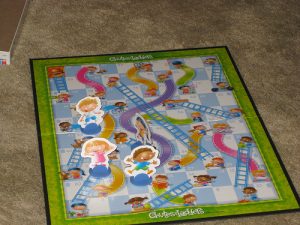There’s a fabulous legal drama that I watch on TV called “The Good Wife”. In the show, Peter Florrick is a former Cook County state’s attorney who has been jailed following a very public sex and corruption scandal. Although he accepts that he betrayed his family by hiring a call girl, he alleges that the corruption charges are false and that he was set up. In Episode 6 of Season 1, Peter is fighting to get his case heard on appeal, have his conviction overturned, and be released from prison.
Here’s a conversation that took place during that episode between Peter and someone who was visiting him in jail:
Visitor: “Do you know what I like about you? You’re three months into a ten year sentence, and you’re plotting your political come-back.”
Peter: “Politics is just a game of Chutes and Ladders. Right now, (he shrugs) I’m at square 1.”
This exchange got me thinking, and it led to this blog post. With the current world economic situation, a lot of people who were far ahead in the game of life are trying to deal with the challenge of finding themselves back at square 1. Perhaps surprisingly, the children’s game of “Chutes and Ladders” can teach us important lessons about dealing with life’s challenges. One of these lessons is the following:
At any moment you could land on a square with a ladder on it and be back at the top of the game; so, wherever you might find yourself on the board at present, just keep moving forward, and keep your eyes open for opportunities.
Keep reading this post and you’ll discover a brief description of the game “Chutes and Ladders”, and an explanation of three valuable life lessons which you can learn from this game.
“Chutes and Ladders” in a Nutshell
In case you’ve never played “Chutes and Ladders”, or it’s been so long since you’ve played that you can’t remember what the game is like, here’s a brief explanation of the game:
The board is divided into 100 squares. All of the players start at square 1 and the objective is to reach square 100 as fast as you can. The first one to reach square 100 is the winner. Everyone takes turns spinning a little wheel which determines how many squares you can move forward. Along the board there are some squares that contain ladders, and some squares that contain chutes.
- If you land on a square with a ladder on it, you can jump ahead and skip over several squares. For example, if you land on square 9–which contains a ladder leading to square 31–you make a sudden jump all the way to square 31.
- If you land on a square with a chute on it, you have to slide back down and you lose a lot of the area you had already covered. For example, if you land on square 49—which contains a chute leading to square 11—you fall all the way down to square 11.
That is, all throughout the board there are opportunities to jump ahead, and there’s the danger of sliding back down. Here are some of the features of the game:
- Anything can change at a moment’s notice.
- Even if it looks like all the other players are ahead of you and that you no longer have a shot at winning, there’s still the possibility that you’ll pull ahead.
The three lessons that you can learn from “Chutes and Ladders” for dealing with life’s challenges are the following:
- Lesson One: Accept That Chutes Are Just Part of the Game
- Lesson Two: Falling Down a Chute May Be a Good Thing
- Lesson Three: There Are Ladders Everywhere
Dealing With Life’s Challenges – Lesson One
The fist lesson in dealing with life’s challenges which you can learn from the game “Chutes and Ladders” is that you need to accept that chutes are just part of the game.
“Chutes and Ladders” is purely a game of chance; there’s no strategy involved. You just spin the wheel and move forward depending on the number the pointer lands on. In this way, “Chutes and Ladders” isn’t like life, because in life there are many things which are under your control. You can create a life plan, and you can take the necessary steps in order to follow your life plan. However, in life, even the best laid plans can lead to a chute.
As an example, you may have heard of retired football coach Lou Holtz. In 1966, Holtz was 28 years old, and he had just been hired by Marvin Bass at the University of South Carolina. This was a great opportunity for Holtz, and he moved his family to South Carolina and spent practically every penny he had to make a down payment on a house.
That’s when Holtz slid down a chute which appeared out of nowhere. Overnight, Bass resigned as head coach and, as result, Holtz was suddenly unemployed. He now had no job, no money, and no prospects, and he had a family to support. Through no fault of his own, he had slid back down to square 1. Even if you’re doing everything right, sometimes a chute will appear out of the blue.
- Some chutes are small: your car breaks down and you have to dip into your savings to buy a new one.
- Some chutes are medium-sized: the company you’re working for is near bankruptcy and, as a result, you have to accept more duties for less pay.
- Some chutes are long: you have to declare bankruptcy, your spouse leaves you, or your house burns down.
Visualize your life as a board game, and include some chutes on that board. After all, chutes are a part of the game of life. I don’t think I’ve ever come across anyone past the age of thirty who has not fallen down a chute at least a couple of times. You should definitely be on the look-out for chutes, and avoid as many of them as you can, but know that sooner or later you will fall down a chute.
Dealing With Life’s Challenges – Lesson Two
The second lesson in dealing with life’s challenges which you can learn from the game “Chutes and Ladders” is that falling down a chute may be a good thing.
In “Chutes and Ladders” there’s one particularly nasty chute which takes you from the very top of the board, back down to the beginning of the game. A lot of people might be tempted to give up when they land on this chute. However, falling down this chute may be a blessing in disguise. This is because when you land on this chute, and you go back to the beginning of the game, it gives you another chance to land on the longest ladder in the game.
Being back at square 1 means that you get to reassess what you want from life, and where you want to end up. It’s an opportunity to go back to the drawing board. Here are some examples:
- Do you want to explore a different career? How about looking for a career that you’re passionate about, instead of just looking for another job that pays the bills?
- Do you want to try your hand at starting your own business?
- Do you want to move to a different city, or even a different country?
- Do you want to reassess your definition of success?
- Are you really happy with your old lifestyle, or do you want to change it? Are you tired of living the lifestyle that others expect from you?
Setbacks can be an opportunity to change strategies or directions. By reassessing your life and making better choices the second time around, you might just end up on a square which takes you up the longest ladder in the game; this would mean getting all the way to the top in no time at all.
Dealing With Life’s Challenges – Lesson Three
The third lesson in dealing with life’s challenges which you can learn from the game “Chutes and Ladders” is that there are ladders everywhere.
Just as chutes are a fact of life, ladders are a fact of life as well. This means that you should keep in mind that there are ladders all around you, and that you should always be on the look-out for opportunities. In addition, just as chutes come in many different sizes, so do ladders.
- There are small ladders: you could get an unexpected check in the mail (a tax refund or someone paying you back for a loan that you had given up on).
- There are medium sized ladders: you meet someone at a party, you mention that you’re job hunting, and they offer you a position in their company.
- There are long ladders: you decide to take business classes, you notice a niche in an area that interests you where’s there’s little competition, and you start a business which gives you financial security and an opportunity to do work which feels like play.
Because there are ladders all around you, you need to do the following:
- Get out there and meet new people.
- Re-establish contact with old acquaintances.
- Try new things.
- Even if you’re down, don’t give up. Keep telling yourself that the next ladder may be just around the corner.
Conclusion
One of the reasons Lou Holtz is famous is because of what he did when he found himself in the predicament which I described above. Here’s what he did: he sat down and he wrote a life list of all the things that he wanted to be, do and have in life. Holtz filled his life list with grandiose, seemingly improbable items. When he was done, he had a list with 107 goals on it, including the following:
- Having dinner at The White House.
- Meeting the pope.
- Becoming head coach at Notre Dame.
- Making a hole-in-one.
- Being on The Tonight Show.
- Jumping out of an airplane.
Holtz has gone on to achieve 95 of his 107 goals, to date. Not bad for a man who was unemployed at the age of 28, with two small children, a pregnant wife, and no money in the bank!
Life is filled with challenges, and the only way to win the game is to find ways to deal with these challenges effectively. Learn the three lessons for dealing with life’s challenges presented above, and apply them as necessary. Even if you’ve recently slid down a chute, and you now find yourself back at square 1, remember that you can still win the game. And the only way to win the game, is to keep playing.


Did you enjoy this article? Subscribe to “Daring to Live Fully” by clicking here and get free updates.


 Marelisa Fabrega is a lawyer and entrepreneur. She holds a Bachelor of Science in Business Administration from Georgetown University in Washington, D.C., as well as a Juris Doctor from the Georgetown University Law Center. You can learn more about her
Marelisa Fabrega is a lawyer and entrepreneur. She holds a Bachelor of Science in Business Administration from Georgetown University in Washington, D.C., as well as a Juris Doctor from the Georgetown University Law Center. You can learn more about her 





